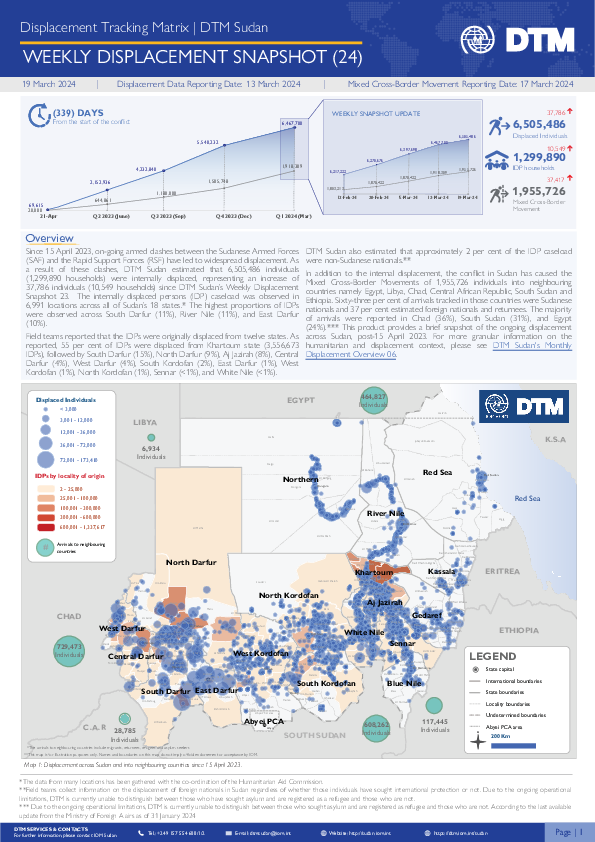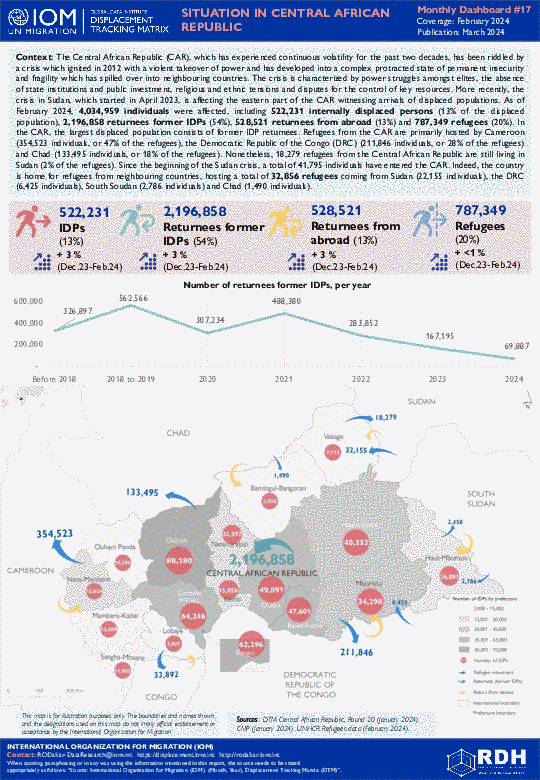-
Countries
-
Data and Analysis
-
Special Focus
-
Crisis Responses

Contact
DTM Europe, DTMMediterranean@iom.int
Language
English
Location
Kosovo 1244
Period Covered
Jul 03 2023
Aug 30 2023
Activity
- Survey
- Flow Monitoring
This report presents the results of the second round of the Displacement Tracking Matrix (DTM) Flow Monitoring Surveys (FMS) collected in Kosovo* from 3 July to 30 August 2023. IOM interviewed a total of 51 individual respondents. The first round of FMS was carried out in June and July 2022. FMS provides a snapshot of the profiles, experiences and needs of migrants residing in Kosovo*. The survey asks questions on demographics, education and employment backgrounds, the circumstances of the migration journey and migration factors, as well as future intentions.
* References to Kosovo shall be understood in the context of United Nations Resolution 1244 (1999).

Contact
DTM Europe, DTMMediterranean@iom.int
Language
English
Location
Republic of Moldova
Period Covered
Jan 01 2023
Dec 31 2023
Activity
- Survey
- Return Intention
Key Findings:
- Out of 8,421 respondents, 92 per cent were planning to return to the same oblast of origin while the remaining 8 per cent aimed to reach a different one. Out of those returning to a different oblast: Kyiv city, Vinnytska and Odeska
- 84 per cent of respondents had crossed back to Ukraine twice or more prior to the survey.
- 58 per cent were already displaced between January and June 2022.
- Respondent's intentions: Short-term visit (56%), Long-term stay (27%), and unknown (17%).
- Main priority needs that were cited by respondents include financial support (34%), medicine and health services (14%) and support with personal safety and security (13%)
- 52 per cent of respondents stated they had no immediate needs.

Contact
DTM Mozambique, DTMMozambique@iom.int
Language
English
Location
Mozambique
Period Covered
Mar 11 2024
Mar 15 2024
Activity
- Other
- Survey
- Return Intention
IOM's Displacement Tracking Matrix (DTM), in collaboration with Mozambique’s Natonal Institute for Disaster Management (INGD) and local authorities in Erati, Nampula, conducted a household-level verication exercise to assess the remaining population displaced by attacks or fear of attacks in Chiure districts, Cabo Delgado. At its peak, Erati hosted over 45,000 internally displaced persons (IDPs) from neighboring Chiure District.
As of March 15, joint verification efforts confirmed the presence of 1,503 IDPs (corresponding to 468 households) still in Namapa and Alua Posto, marking a 70% decrease from the peak between February 19-24. Nacuxa School no longer hosts any families. Children make up 53% of those remaining displaced within the district.
The Central African Republic (CAR), which has experienced continuous volatility for the past two decades, has been riddled by a crisis which ignited in 2012 with a violent takeover of power and has developed into a complex protracted state of permanent insecurity and fragility which has spilled over into neighbouring countries. The crisis is characterized by power struggles amongst elites, the absence of state institutions and public investment, religious and ethnic tensions and disputes for the control of key resources. More recently, the crisis in Sudan, which started in April 2023, is affecting the eastern part of the CAR witnessing arrivals of displaced populations.
As of February 2024, 4,034,959 individuals were affected, including 522,231 internally displaced persons (13% of the displaced population), 2,196,858 returnees former IDPs (54%), 528,521 returnees from abroad (13%) and 787,349 refugees (20%). In the CAR, the largest displaced population consists of former IDP returnees. Refugees from the CAR are primarily hosted by Cameroon (354,523 individuals, or 47% of the refugees), the Democratic Republic of the Congo (DRC) (211,846 individuals, or 28% of the refugees) and Chad (133,495 individuals, or 18% of the refugees). Nonetheless, 18,279 refugees from the Central African Republic are still living in Sudan (2% of the refugees). Since the beginning of the Sudan crisis, a total of 41,795 individuals have entered the CAR. Indeed, the country is home for refugees from neighbouring countries, hosting a total of 32,856 refugees coming from Sudan (22,155 individuals), the DRC (6,425 individuals), South Soudan (2,786 individuals) and Chad (1,490 individuals).

Contact
DTM Sudan; dtmsudan@iom.int
Language
English
Location
Sudan
Period Covered
Mar 08 2024
Mar 13 2024
Activity
- Mobility Tracking
- Baseline Assessment
Overview
On 15 April 2023, armed clashes erupted between the Sudanese Armed Forces (SAF) and the Rapid Support Forces (RSF) in multiple cities across Sudan. Clashes initially took place in cities across Northern and Khartoum states, later spreading across the Darfur and Kordofan regions.
Highlights
- DTM Sudan estimates that 6,505,486 individuals (1,299,890 households) were recently internally displaced.
- The IDP caseload was observed in 6,991 locations across all of Sudan’s 18 states.
- The highest proportions of IDPs were observed across South Darfur (11%), River Nile (11%), and East Darfur (10%).
- Field teams reported that the IDPs observed were originally displaced from twelve states. The majority (3,556,673 IDPs, 55%) were reportedly displaced from Khartoum state; followed by South Darfur (15%), North Darfur (9%), Aj Jazirah (8%), Central Darfur (4%), West Darfur (4%), South Kordofan (2%), East Darfur (1%), West Kordofan (1%), North Kordofan (1%), Sennar (<1%) and White Nile (<1%).
- IOM-DTM also reported that an estimated 1,955,726 mixed cross-border movements were made into neighbouring countries.
- This product provides brief insights into those displaced in Sudan post-15 April 2023. For more granular information on the IDP caseload and the displacement context, please see IOM-DTM's Monthly Displacement Overview 06.

Contact
DTM Europe, DTMMediterranean@iom.int
Language
Bosnian, Croatian, Serbian
Location
Serbia
Period Covered
Feb 01 2024
Feb 29 2024
Activity
- Survey
- Flow Monitoring
This report, based on a multi-method and multi-source approach, provides insights into the profiles, experiences and journeys of migrants transiting through the Republic of Serbia.
Data was collected from 1 to 29 February 2024 together with the Commissariat for Refugees and Migrants of the Republic of Serbia (SCRM). IOM interviewed 365 migrants in 9 reception centers.

Contact
DTM Europe, DTMMediterranean@iom.int
Language
English
Location
Serbia
Period Covered
Feb 01 2024
Feb 29 2024
Activity
- Survey
- Flow Monitoring
This report, based on a multi-method and multi-source approach, provides insights into the profiles, experiences and journeys of migrants transiting through the Republic of Serbia.
Data was collected from 1 to 29 February 2024 together with the Commissariat for Refugees and Migrants of the Republic of Serbia (SCRM). IOM interviewed 365 migrants in 9 reception centers.

Contact
DTM Europe, DTMMediterranean@iom.int
Language
Bosnian, Croatian, Serbian
Location
Bosnia & Herzegovina
Period Covered
Feb 01 2024
Feb 29 2024
Activity
- Survey
- Flow Monitoring
This report, based on a multi-method and multi-source approach, provides insights into the profiles, experiences, needs, routes travelled and intentions of migrants transiting through Bosnia and Herzegovina.
Data was collected from 1 February to 29 February 2024. IOM carried out a route observation exercise to monitor trends in entries and exits as well as transit modalities within BiH. IOM also surveyed 792 migrants in active transit locations such as bus stops or at key entry and exit locations throughout the country as well as in 4 transit reception centres.

Contact
DTM Europe, DTMMediterranean@iom.int
Language
English
Location
Bosnia & Herzegovina
Period Covered
Feb 01 2024
Feb 29 2024
Activity
- Survey
- Flow Monitoring
This report, based on a multi-method and multi-source approach, provides insights into the profiles, experiences, needs, routes travelled and intentions of migrants transiting through Bosnia and Herzegovina.
Data was collected from 1 February to 29 February 2024. IOM carried out a route observation exercise to monitor trends in entries and exits as well as transit modalities within BiH. IOM also surveyed 792 migrants in active transit locations such as bus stops or at key entry and exit locations throughout the country as well as in 4 transit reception centres.

Contact
DTMAfghanistan@iom.int
Language
English
Location
Afghanistan
Period Covered
Mar 03 2024
Mar 09 2024
Activity
- Survey
- Flow Monitoring Survey
- Flow Monitoring
In response to recent movements, IOM Afghanistan re-launched its DTM Flow Monitoring activity at the beginning of 2024 to better understand the mobility dynamics at Afghanistan’s borders. On 10 January 2024, DTM began deploying field teams at four border crossing points with the Islamic Republic of Iran (IRN) and Pakistan (PAK), expanding to another border crossing point Ghulam Khan as of 11 February (see map below for the locations of all five crossing points), to conduct two interlinked exercises. The first is a headcount of all individuals entering or leaving Afghanistan (including returnees), also called Flow Monitoring Counting (FMC), to gauge flow volume. The second is a survey of randomly selected Afghan national individuals or groups entering or leaving Afghanistan, also called the Flow Monitoring Survey (FMS), to understand the profiles, motivations, and vulnerabilities of the target population. This snapshot provides key findings combining various IOM data sources, including DTM Afghanistan’s FMC and FMS activities, DTM Pakistan’s Flow Monitoring of Afghan returnees, and IOM Afghanistan’s Cross-Border Post-Arrival Humanitarian Assistance (CB-PAHA) program, for the period 3 to 9 March 2024. For more information about methodology, see the the section in the last page of this report titled “IOM INFLOW DATA.”

